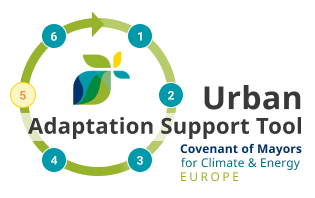
Implementing adaptation
5.1 Designing an effective adaptation action plan
Once climate change risks and vulnerabilities have been assessed (Step 2) and preferred adaptation options have been identified and selected (Step 3 and Step 4), a framework for implementation of adaptation action - strategy and action plan - can be established. To be effective, this framework needs to take into consideration the findings from steps 1 to 4 and be subject to public consultation and formal recognition by the relevant local authorities.
The new Adaptation Strategy stipulates that the EU will help local and regional authorities move from planning to action, by piloting a policy support facility. This facility will provide direct technical assistance to help develop and implement their adaptation strategies and plans. Currently the policy support facility is in its design phase and is expected to be launched by end 2021.
Implementation of adaptation actions, when not entirely mainstreamed into existing sectoral policies, is usually guided by a dedicated adaptation strategy and an accompanying action plan.
The adaptation strategy is a reference document outlining the vision and direction of actions and their expected outcomes. Its accompanying action plan sets out what needs to be done to transform the chosen adaptation options into actions.
Often, local authorities develop both a plan and a strategy as a single document, called either "adaptation strategy" or "adaptation plan" (see examples in Step 5.2). The adaptation strategy may also be incorporated in other, e.g. sectoral, planning documents. In any case, it is recommended that a draft of the adaptation strategy is discussed in a public consultation with all relevant stakeholders (see Step 1.6).
Some possible elements of an adaptation strategy are:
- Introduction explaining why adaptation is needed, e.g. current and expected climate change impacts (see Step 2.1)
- Consideration of the outcomes of assessment of risks and vulnerable sectors (see Step 2.4)
- Approach in developing the strategy, e.g. cooperation with authorities inside and outside the municipality and other public and private stakeholders (see Step 1.6)
- Aims/objectives of adaptation and strategic directions
- Provisions for monitoring and evaluation and revision of the strategy (see Step 6)
- Future outlook
In some cases, when an adaptation strategy already exists at national or regional level, municipalities may decide not to develop a dedicated strategy but develop their adaptation action plan in line with this national/regional strategy.
The action plan accompanying the strategy sets out what needs to be done to turn the prioritised adaptation options (Step 4) into actions. An action plan contains, at least:
- Details of each action (and sub-actions, if applicable) and associated processes and synergies
- Roles and responsibilities in coordination and undertaking of actions
- Timeframe for implementation
- Estimation of human and financial resources needed and/or available funding schemes
- Information needs, open research questions and ways to close knowledge gaps
- Indicators of success to be used for monitoring and evaluation (Step 6)
If the main chosen approach to implementing adaptation to climate change is through mainstreaming into the existing policy documents and plans (see Step 5.3), it is nevertheless advisable to develop a strategic and/or planning document outlining the key impacts, sectors and policies for the integration of adaptation aspects. This overview will facilitate coordination of the mainstreaming activities.
For a framework for implementing adaptation actions to be effective, it is essential to obtain political approval. Formal recognition of the developed strategy and accompanying action plan would also ensure sustainability of adaptation actions in the long term.
